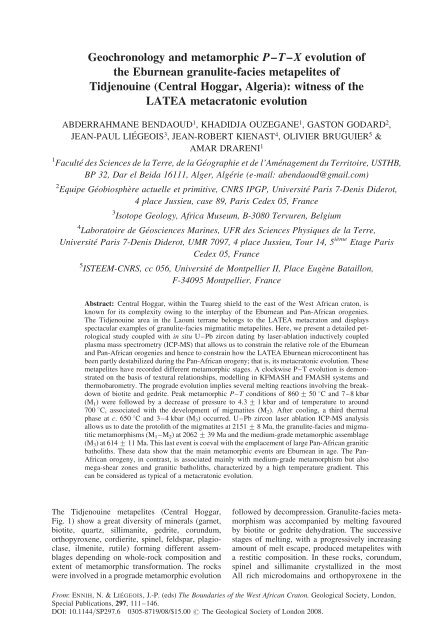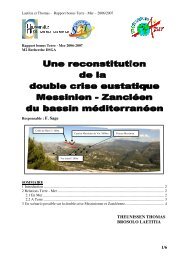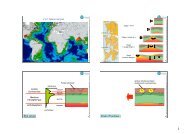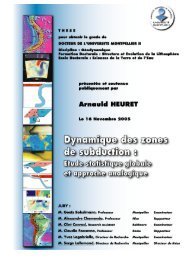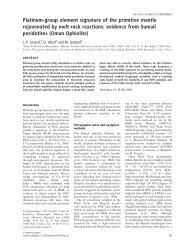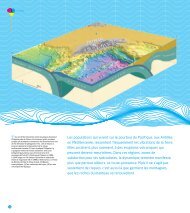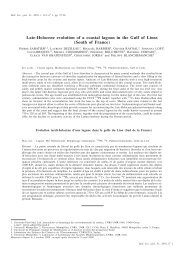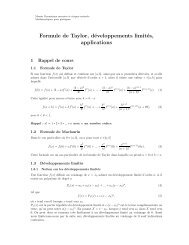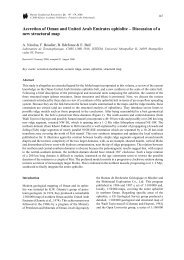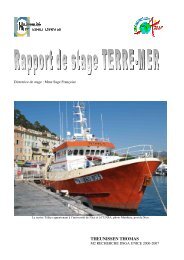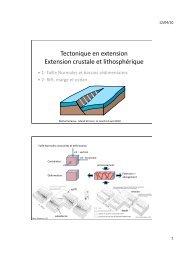Géochronologie U-Pb par ablation laser et ICP-MS (LA-ICP-MS ...
Géochronologie U-Pb par ablation laser et ICP-MS (LA-ICP-MS ...
Géochronologie U-Pb par ablation laser et ICP-MS (LA-ICP-MS ...
You also want an ePaper? Increase the reach of your titles
YUMPU automatically turns print PDFs into web optimized ePapers that Google loves.
Geochronology and m<strong>et</strong>amorphic P–T–X evolution of<br />
the Eburnean granulite-facies m<strong>et</strong>apelites of<br />
Tidjenouine (Central Hoggar, Algeria): witness of the<br />
<strong>LA</strong>TEA m<strong>et</strong>acratonic evolution<br />
ABDERRAHMANE BENDAOUD 1 , KHADIDJA OUZEGANE 1 , GASTON GODARD 2 ,<br />
JEAN-PAUL LIÉGEOIS 3 , JEAN-ROBERT KIENAST 4 , OLIVIER BRUGUIER 5 &<br />
AMAR DRARENI 1<br />
1 Faculté des Sciences de la Terre, de la Géographie <strong>et</strong> de l’Aménagement du Territoire, USTHB,<br />
BP 32, Dar el Beida 16111, Alger, Algérie (e-mail: abendaoud@gmail.com)<br />
2 Equipe Géobiosphère actuelle <strong>et</strong> primitive, CNRS IPGP, Université Paris 7-Denis Diderot,<br />
4 place Jussieu, case 89, Paris Cedex 05, France<br />
3 Isotope Geology, Africa Museum, B-3080 Tervuren, Belgium<br />
4 Laboratoire de Géosciences Marines, UFR des Sciences Physiques de la Terre,<br />
Université Paris 7-Denis Diderot, UMR 7097, 4 place Jussieu, Tour 14, 5 ième Etage Paris<br />
Cedex 05, France<br />
5 ISTEEM-CNRS, cc 056, Université de Montpellier II, Place Eugène Bataillon,<br />
F-34095 Montpellier, France<br />
Abstract: Central Hoggar, within the Tuareg shield to the east of the West African craton, is<br />
known for its complexity owing to the interplay of the Eburnean and Pan-African orogenies.<br />
The Tidjenouine area in the Laouni terrane belongs to the <strong>LA</strong>TEA m<strong>et</strong>acraton and displays<br />
spectacular examples of granulite-facies migmatitic m<strong>et</strong>apelites. Here, we present a d<strong>et</strong>ailed p<strong>et</strong>rological<br />
study coupled with in situ U–<strong>Pb</strong> zircon dating by <strong>laser</strong>-<strong>ablation</strong> inductively coupled<br />
plasma mass spectrom<strong>et</strong>ry (<strong>ICP</strong>-<strong>MS</strong>) that allows us to constrain the relative role of the Eburnean<br />
and Pan-African orogenies and hence to constrain how the <strong>LA</strong>TEA Eburnean microcontinent has<br />
been <strong>par</strong>tly destabilized during the Pan-African orogeny; that is, its m<strong>et</strong>acratonic evolution. These<br />
m<strong>et</strong>apelites have recorded different m<strong>et</strong>amorphic stages. A clockwise P–T evolution is demonstrated<br />
on the basis of textural relationships, modelling in KFMASH and FMASH systems and<br />
thermobarom<strong>et</strong>ry. The prograde evolution implies several melting reactions involving the breakdown<br />
of biotite and gedrite. Peak m<strong>et</strong>amorphic P–T conditions of 860 + 50 8C and 7–8 kbar<br />
(M 1 ) were followed by a decrease of pressure to 4.3 + 1 kbar and of temperature to around<br />
700 8C, associated with the development of migmatites (M 2 ). After cooling, a third thermal<br />
phase at c. 650 8C and 3–4 kbar (M 3 ) occurred. U–<strong>Pb</strong> zircon <strong>laser</strong> <strong>ablation</strong> <strong>ICP</strong>-<strong>MS</strong> analysis<br />
allows us to date the protolith of the migmatites at 2151 + 8 Ma, the granulite-facies and migmatitic<br />
m<strong>et</strong>amorphisms (M 1 –M 2 ) at 2062 + 39 Ma and the medium-grade m<strong>et</strong>amorphic assemblage<br />
(M 3 ) at 614 + 11 Ma. This last event is coeval with the emplacement of large Pan-African granitic<br />
batholiths. These data show that the main m<strong>et</strong>amorphic events are Eburnean in age. The Pan-<br />
African orogeny, in contrast, is associated mainly with medium-grade m<strong>et</strong>amorphism but also<br />
mega-shear zones and granitic batholiths, characterized by a high temperature gradient. This<br />
can be considered as typical of a m<strong>et</strong>acratonic evolution.<br />
The Tidjenouine m<strong>et</strong>apelites (Central Hoggar,<br />
Fig. 1) show a great diversity of minerals (garn<strong>et</strong>,<br />
biotite, quartz, sillimanite, gedrite, corundum,<br />
orthopyroxene, cordierite, spinel, felds<strong>par</strong>, plagioclase,<br />
ilmenite, rutile) forming different assemblages<br />
depending on whole-rock composition and<br />
extent of m<strong>et</strong>amorphic transformation. The rocks<br />
were involved in a prograde m<strong>et</strong>amorphic evolution<br />
followed by decompression. Granulite-facies m<strong>et</strong>amorphism<br />
was accompanied by melting favoured<br />
by biotite or gedrite dehydration. The successive<br />
stages of melting, with a progressively increasing<br />
amount of melt escape, produced m<strong>et</strong>apelites with<br />
a restitic composition. In these rocks, corundum,<br />
spinel and sillimanite crystallized in the most<br />
All rich microdomains and orthopyroxene in the<br />
From: ENNIH, N.&LIÉGEOIS, J.-P. (eds) The Boundaries of the West African Craton. Geological Soci<strong>et</strong>y, London,<br />
Special Publications, 297, 111–146.<br />
DOI: 10.1144/SP297.6 0305-8719/08/$15.00 # The Geological Soci<strong>et</strong>y of London 2008.


